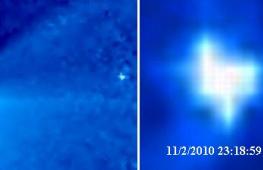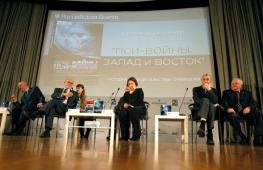Demonstration version of the exam in the history of the year. Appointment of KIM USE
What will be the exam in history in 2016
What parts have been removed compared to 2015
Should I panic and be afraid?
What is the main thing in preparing for the exam in history 2016?
All these questions are answered in the video above. Hello everyone. So, the 2015/2016 academic year is coming soon and Federal Institute Pedagogical Measurements (FIPI) on its website has already published fresh control and measuring materials for the Unified State Examination in 2016. This post is about history.
The first thing that catches your eye: in the USE test in history 2016, the former part A was completely removed from the first part USE test. It contained the easiest tasks with one answer, usually out of four. The elimination of these tasks, on the one hand, significantly reduced the number of tasks itself: now there are 25 instead of 40. On the other hand, the exam itself in the history of 2016 is complicated. Not to say that strong, but complicated.
Here is a table of correspondence between the tasks of KIM USE 2016 in history and:
As can be seen from the table, only 5 tasks (6,7,8, 10 and 25) fairly new (they are marked in red). The rest of the tasks are taken from the 2015 USE test. When I say this, I mean the type of tasks. The most fundamental change occurred in task 6. Its introduction will complicate the test by the fact that the graduate will have to navigate similar tasks from different historical eras.
Task 25 (40) has also been radically revised. If earlier a graduate was required to characterize a historical figure according to an unclear plan, now it is required to write a historical essay on a specific period national history.
That is, now it is not at all necessary to know the biography of W. Churchill and T. Roosevelt in order to write a historical essay. The principle here is simple: don't write what you don't know 🙂 However, knowing these characters and demonstrating this knowledge to experts will help the graduate get the highest score.
The maximum primary score is now 53 primary scores and 100 tests. For a historical essay, a graduate can now receive as many as 11 primary points. And the criteria in it have been increased to 7. We will talk more about these tasks in future videos and posts. Subscribe to project news !
In general, the test has become more difficult and the graduate will have to know not only events from history and historical figures, but also terms, causal relationships and much, much more.

You can seriously train in solving tests, and learn the nuances of their solution, by going through our:

Many will ask: are they relevant for preparing for the exam in history in 2016. Yes, of course they are relevant. After all, my video courses are aimed at developing a graduate's systemic knowledge of the discipline and developing the skill of solving tests of any complexity.
In addition, all those who have purchased a full course in history from me, like other courses, have the right to consult with me on any issues of preparing for the exam. Therefore, everyone who purchased my courses and my services in 2015/2016 academic year without a doubt, they will pass the exam in the history of 2016 by 100 points. As it was in the 2014/2015 academic year.
You can download the latest KIM USE on the history of 2016 here by liking:
Download >>
I hope I dispelled your fears and panic moods! Interesting items next: subscribe to site news !
Sincerely, Andrey Puchkov
Specification
control measuring materials
for the 2016 unified state exam
HISTORY
1. Appointment of KIM USE
The Unified State Examination (USE) is a form of objective assessment of the quality of training of persons who have mastered educational programs middle general education, using tasks of a standardized form (control measuring materials).
The exam is held in accordance with federal law dated December 29, 2012 No. 273-FZ “On Education in the Russian Federation”.
Control measuring materials allow you to establish the level of knowledge and skills mastered by graduates in the course of history in accordance with the requirements of the Federal component state standards secondary (complete) general education, basic and specialized levels.
The results of the unified state exam in history are recognized educational organizations higher vocational education how are the results entrance examinations by history.
2. Documents defining the content of KIM
3. Approaches to the selection of content and the development of the structure of KIM
The examination work covers the content of the Russian history course from antiquity to the present with the inclusion of elements of world history (the history of wars, diplomacy, culture, economic relations, etc.) and is aimed at identifying the educational achievements of graduates of secondary educational institutions.
KIM tasks include a significant layer of factual material. At the same time, special attention is paid to testing the analytical and information and communication skills of graduates. Attention is focused on tasks aimed at testing skills: to systematize historical facts; establish causal, structural and other relationships; use sources of information of different types (text source, table, historical map, illustration) to solve cognitive problems; argue your own position with the involvement of historical knowledge; present the results of historical and cognitive activity in a free form with a focus on the specified parameters of activity. Orientation to the active work of the examinees, as well as the involvement of a wide range of historical sources, problematic historical materials create
opportunities to identify graduates who are most focused on continuing their education in this field. All of the above makes it possible to qualitatively differentiate the participants in the exam according to the level of their preparation in history.
4. The structure of KIM USE
Each version of the examination paper consists of two parts and includes 25 tasks that differ in form and level of complexity.
Part 1 contains 19 short answer tasks.
V examination work The following types of tasks with a short answer are offered:
- tasks for choosing and recording one or more correct answers from the proposed list of answers;
- tasks for determining the sequence of location of these elements;
- tasks for establishing the correspondence of elements given in several information rows;
- assignments for the definition on the specified grounds and recording in the form of a word (phrase) of a term, title, name, century, year, etc.
The answer to the tasks of part 1 is given by the corresponding entry in the form of a number or a sequence of numbers, written without spaces and other separators; the words; phrases (also written without spaces and other separators).
Part 2 contains 6 tasks with a detailed answer, identifying and evaluating the development of various complex skills by graduates.
20-22 - a set of tasks related to analysis historical source(carrying out source attribution; extracting information; attracting historical knowledge to analyze the problems of the source, the position of the author).
23-25 - tasks related to the use of methods of cause-and-effect, structural-functional, temporal and spatial analysis for the study of historical processes and phenomena. Task 23 is connected with the analysis of any historical problem, situation. Task 24 - analysis of historical versions and estimates, argumentation various points vision with engaging knowledge of the course. Task 25 involves writing historical essay. Task 25 is alternative: the graduate has the opportunity to choose one of the three periods in the history of Russia and demonstrate his knowledge and skills on the most familiar historical material. Task 25 is evaluated according to a system of criteria.
Table 1. Distribution of tasks by parts of the examination paper
5. Distribution of KIM USE tasks by content, types of skills and methods of activity
The work is built on the basis of the requirements of the Historical and Cultural Standard, each section of which consists of the following components: a brief description of period, including the main events, phenomena, processes; list of concepts and terms; list of personalities; List of sources; list of key dates. Each of these parts carries a significant amount of information that is mandatory for study at school. Particular attention in the Historical and Cultural Standard is given to the study of cultural issues. The concept of a new educational and methodological complex on national history, of which the Historical and Cultural Standard is a part, indicates the need to work with a historical map. It is also necessary to take into account the general patriotic orientation of the ICS, which, in particular, is manifested in increased attention to the study of the history of the Great Patriotic War.
These requirements of the Historical and Cultural Standard became the basis for determining the structure of the examination work.
Specification
control measuring materials
for holding the unified state exam in 2016
HISTORY
1. Appointment of KIM USE
The Unified State Examination (USE) is a form of objective assessment of the quality of training of persons who have mastered the educational programs of secondary general education, using tasks in a standardized form (control measuring materials).
The USE is conducted in accordance with Federal Law No. 273-FZ of December 29, 2012 “On Education in the Russian Federation”.
Control measuring materials allow to establish the level of mastering knowledge and skills by graduates in the course of history in accordance with the requirements of the Federal component of state standards of secondary (complete) general education, basic and profile levels.
The results of the unified state exam in history are recognized by educational institutions of higher professional education as the results of entrance examinations in history.
2. Documents defining the content of KIM
3. Approaches to the selection of content and the development of the structure of KIM
The examination work covers the content of the Russian history course from antiquity to the present with the inclusion of elements of world history (the history of wars, diplomacy, culture, economic relations, etc.) and is aimed at identifying the educational achievements of graduates of secondary educational institutions.
KIM tasks include a significant layer of factual material. At the same time, special attention is paid to testing the analytical and information and communication skills of graduates. Attention is focused on tasks aimed at testing skills: to systematize historical facts; establish causal, structural and other relationships; use sources of information of different types (text source, table, historical map, illustration) to solve cognitive problems; argue your own position with the involvement of historical knowledge; present the results of historical and cognitive activity in a free form with a focus on the specified parameters of activity. Orientation to the active work of the examinees, as well as the involvement of a wide range of historical sources, problematic historical materials create
opportunities to identify graduates who are most focused on continuing their education in this field. All of the above makes it possible to qualitatively differentiate the participants in the exam according to the level of their preparation in history.
4. The structure of KIM USE
Each version of the examination paper consists of two parts and includes 25 tasks that differ in form and level of complexity.
Part 1 contains 19 short answer tasks.
In the examination paper, the following types of tasks with a short answer are proposed:
- tasks for choosing and recording one or more correct answers from the proposed list of answers;
- tasks for determining the sequence of location of these elements;
- tasks for establishing the correspondence of elements given in several information rows;
- assignments for the definition on the specified grounds and recording in the form of a word (phrase) of a term, title, name, century, year, etc.
The answer to the tasks of part 1 is given by the corresponding entry in the form of a number or a sequence of numbers, written without spaces and other separators; the words; phrases (also written without spaces and other separators).
Part 2 contains 6 tasks with a detailed answer, identifying and evaluating the development of various complex skills by graduates.
20-22 - a set of tasks related to the analysis of a historical source (conducting source attribution; extracting information; attracting historical knowledge to analyze the problems of the source, the position of the author).
23-25 - tasks related to the use of methods of cause-and-effect, structural-functional, temporal and spatial analysis for the study of historical processes and phenomena. Task 23 is connected with the analysis of any historical problem, situation. Task 24 - analysis of historical versions and assessments, argumentation of different points of view with the involvement of knowledge of the course. Task 25 involves writing a historical essay. Task 25 is alternative: the graduate has the opportunity to choose one of the three periods in the history of Russia and demonstrate his knowledge and skills on the most familiar historical material. Task 25 is evaluated according to a system of criteria.
Table 1. Distribution of tasks by parts of the examination paper
5. Distribution of KIM USE tasks by content, types of skills and methods of activity
The work is built on the basis of the requirements of the Historical and Cultural Standard, each section of which consists of the following components: a brief description of the period, including the main events, phenomena, processes; list of concepts and terms; list of personalities; List of sources; list of key dates. Each of these parts carries a significant amount of information that is mandatory for study at school. Particular attention in the Historical and Cultural Standard is given to the study of cultural issues. The concept of a new educational and methodological complex on national history, of which the Historical and Cultural Standard is a part, indicates the need to work with a historical map. It is also necessary to take into account the general patriotic orientation of the ICS, which, in particular, is manifested in increased attention to the study of the history of the Great Patriotic War.
These requirements of the Historical and Cultural Standard became the basis for determining the structure of the examination work.
history like school subject, most often when studying, students are not very interested, since faces and dates appear there all the time. And it's hard to remember! How to remember in what years this or that king ruled, what reforms were carried out by him, and which by his predecessors and followers? All this is so confusing that not all students will still take the exam in history in 2016. And yet, it must be said that the USE demos on the history of 2016 are still in demand among students. This is due to the fact that history is needed for admission to many specialties, and first of all, this applies to law faculties. That is why demo versions are subject to download, since the exam in history will have to be passed by those students who have chosen universities that require this subject for admission.
FIPI demo version history of the Unified State Examination 2016
So the year 2016 is coming, and we are thinking about what we need to take the exam in history, since our future is not in the hands of others, but in our heads. You need to think and study in order to be able to pass the history on the exam. And this is a very difficult task, and especially for those students who did not devote time to studying history at school. special attention. And, unfortunately, most of them are. Most of all, a person hopes for his exclusivity, as well as for "maybe", which should help him during fulfillment of the exam. But you need to know for sure that such things do not allow you to perform real USE assignments in history, because in 2016 FIPI will compile them for you again in difficult variant which, without information, you won’t understand and simply won’t do!



